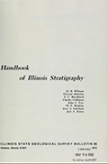Historical:Harmony Hill Shale Member
Lithostratigraphy: Ottawa Limestone Megagroup >>Ancell Group >>Glenwood Formation >>Harmony Hill Shale Member
Chronostratigraphy: Paleozoic Erathem >>Ordovician System >>Champlainian Series >>Blackriveran Stage
Allostratigraphy: Tippecanoe Sequence
Authors
H. B. Willman and T. C. Buschbach
Name Origin
The Harmony Hill Shale Member of the Glenwood Formation (Templeton and Willman, 1963, p. 52), the uppermost member, is named for Harmony Hill School.
Type Section
The type section of the Harmon Hill Shale Member is located 1 mile southeast of Harmony Hill School in a ravine 5 miles north of Grand Detour, Ogle County (W1/2 SE SE NE 24, 23N-9E), where the member is 5.9 feet thick.
Other Names
In some areas in the Upper Mississippi Valley the Harmony Hill Shale Member is the only unit included in the Glenwood and is called the Glenwood Shale.
Extent and Thickness
The Harmony Hill Shale Member is the most widely distributed member of the Glenwood Formation but is locally absent in the outcrop area and is generally absent in subsurface in northeastern Illinois. It is commonly 1-5 feet thick but has a maximum thickness of 27 feet in southwestern Ogle County.
Stratigraphic Position
The Harmony Hill Shale Member is conformable, usually gradational, with the underlying members, but it locally rests unconformably on the St. Peter Sandstone. It is unconformably overlain by the Pecatonica Formation.
Description
The Harmony Hill Member is a green, pyritic, finely laminated shale containing thin laminae of silt and very fine sand, but in places it becomes very sandy, and locally it is black. Phosphatic pellets are common near the top.
Fossils
The Harmony Hill Shale Member contains a few fragments of scolecodonts, Lingula, and minute, dark red algae or spores.
References
TEMPLETON, J. S., and H. B. WILLMAN, 1963, Champlainian Series (Middle Ordovician) in Illinois: Illinois State Geological Survey Bulletin 89, 260 p.
ISGS Codes
| Stratigraphic Code | Geo Unit Designation |
|---|---|
